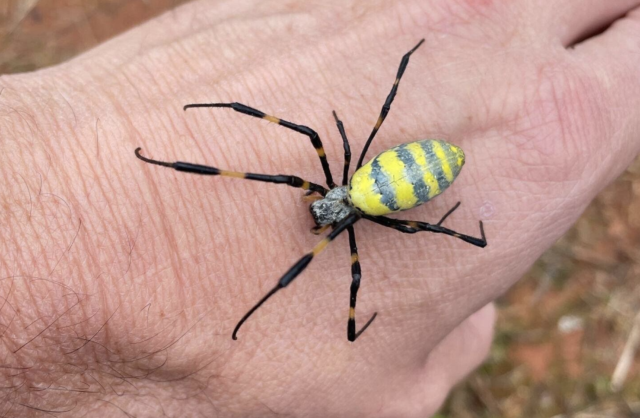As prospective home buyers consider relocating to Myrtle Beach, one aspect that often comes to mind is the local wildlife, including insects and spiders. Understanding the types of bugs and spiders found in Myrtle Beach can help home buyers make informed decisions about pest control measures and potential encounters with these creatures. In moving here from Oklahoma, USA, (also known as the Australia of the Mid-West), I quickly found out that Oklahoma is rivaled by South Carolina by their “giant spider that looks like it will kill you population”. Fortunately, most of the big spiders I’ve found in Myrtle Beach have been well mannered Riding Spiders…but I digress. Here’s what you need to know about our insect population in Myrtle Beach:
Common Bugs and Spiders in Myrtle Beach:
Myrtle Beach, located along the scenic coastline of South Carolina, is home to a variety of bugs and spiders. While many of these creatures play essential roles in the ecosystem, some may pose nuisance or health risks to homeowners. Let’s take a closer look at some of the common bugs and spiders found in the area:
- Palmetto Bugs (American Cockroaches):
Palmetto bugs, also known as American cockroaches, are among the most common pests encountered in Myrtle Beach homes. These large insects are attracted to warm, humid environments and often seek shelter indoors, especially during hot summer months. Palmetto bugs can contaminate food and surfaces, posing sanitation concerns for homeowners. - Ants:
Several ant species are prevalent in Myrtle Beach, including fire ants, Argentine ants, and odorous house ants. While some ants may simply be a nuisance, others can cause property damage or deliver painful bites to humans and pets. Ant infestations can occur both indoors and outdoors, requiring proactive pest management strategies. - Mosquitoes:
Mosquitoes thrive in the warm, humid climate of Myrtle Beach and are particularly active during the summer months. These blood-feeding insects not only cause discomfort with their bites but also pose health risks by transmitting diseases such as West Nile virus and Eastern equine encephalitis. Homeowners may implement mosquito control measures to reduce breeding sites and minimize exposure to these pests. - Spiders:
Several spider species inhabit Myrtle Beach, including common house spiders, wolf spiders, and black widow spiders. While most spiders are harmless and play a beneficial role in controlling insect populations, black widow spiders pose a venomous threat to humans. Homeowners should exercise caution when encountering spiders and seek professional pest control assistance if necessary. - Palmetto Weevils:
Palmetto weevils are destructive pests that target palm trees, including the iconic palmetto palms found throughout Myrtle Beach. These beetles bore into palm trees to lay eggs, causing structural damage and potential death to the trees. Homeowners with palm trees on their property should be vigilant for signs of palmetto weevil infestation and take proactive measures to protect their trees.
Preventive Measures and Pest Control:
As prospective home buyers evaluate properties in Myrtle Beach, it’s essential to consider preventive measures and pest control strategies to minimize encounters with bugs and spiders. Here are some tips for homeowners:
- Seal Entry Points: Inspect your home for gaps, cracks, and openings that may serve as entry points for pests. Seal gaps around doors, windows, and utility penetrations to prevent bugs from entering indoors.
- Maintain Cleanliness: Keep your home clean and free of food debris, crumbs, and standing water that may attract pests. Regularly clean kitchen surfaces, dispose of trash promptly, and store food in sealed containers to deter pests.
- Trim Vegetation: Maintain landscaping around your home by trimming bushes, shrubs, and trees to reduce harborage areas for pests. Keep vegetation away from the exterior walls of your home to prevent bugs from gaining access indoors.
- Pest Control Services: Consider hiring professional pest control services to inspect your home, identify potential pest issues, and implement targeted treatment plans. Regular pest inspections and preventive treatments can help keep bugs and spiders at bay.
As prospective home buyers explore the beautiful coastal region of Myrtle Beach, it’s essential to be aware of the types of bugs and spiders commonly found in the area. By understanding the local pest fauna and implementing preventive measures, homeowners can minimize pest encounters and maintain a comfortable living environment. With proactive pest management strategies in place, homeowners can enjoy the natural beauty of Myrtle Beach without the nuisance of unwanted pests.
Bibliography:
- University of Florida – Featured Creatures: American Cockroach (Periplaneta americana)
[https://entnemdept.ufl.edu/creatures/urban/roaches/american_cockroach.htm] - Clemson Cooperative Extension – Ants
[https://hgic.clemson.edu/factsheet/ants/] - Centers for Disease Control and Prevention (CDC) – Mosquitoes and Mosquito Control
[https://www.cdc.gov/mosquitoes/index.html] - University of Florida – Featured Creatures: Black Widow Spider (Latrodectus spp.)
[https://entnemdept.ufl.edu/creatures/urban/spiders/latrodectus.htm] - South Carolina Forestry Commission – Palmetto Weevil
[https://www.state.sc.us/forest/pests/palweev.htm]









